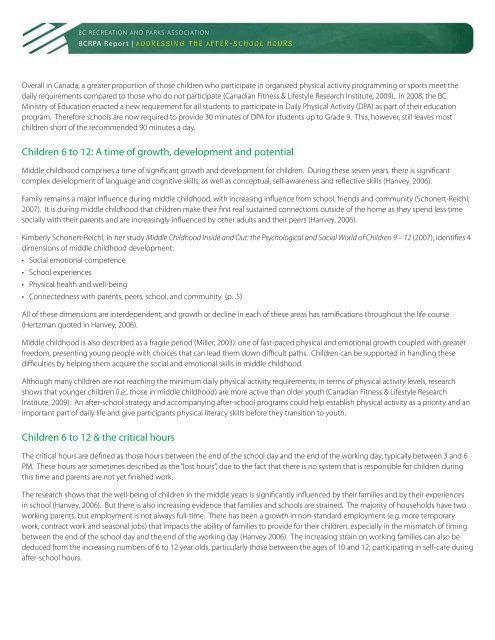BCRPA Report: Addressing the after-school hours - Middle ...
BCRPA Report: Addressing the after-school hours - Middle ...
BCRPA Report: Addressing the after-school hours - Middle ...
You also want an ePaper? Increase the reach of your titles
YUMPU automatically turns print PDFs into web optimized ePapers that Google loves.
8 | www.bcrpa.bc.ca<br />
BC RECREATION AND PARKS ASSOCIATION<br />
<strong>BCRPA</strong> <strong>Report</strong> |<br />
Overall in Canada, a greater proportion of those children who participate in organized physical activity programming or sports meet <strong>the</strong><br />
daily requirements compared to those who do not participate (Canadian Fitness & Lifestyle Research Institute, 2009). In 2008, <strong>the</strong> BC<br />
Ministry of Education enacted a new requirement for all students to participate in Daily Physical Activity (DPA) as part of <strong>the</strong>ir education<br />
program. Therefore <strong>school</strong>s are now required to provide 30 minutes of DPA for students up to Grade 9. This, however, still leaves most<br />
children short of <strong>the</strong> recommended 90 minutes a day.<br />
Children 6 to 12: A time of growth, development and potential<br />
<strong>Middle</strong> childhood comprises a time of significant growth and development for children. During <strong>the</strong>se seven years, <strong>the</strong>re is significant<br />
complex development of language and cognitive skills, as well as conceptual, self-awareness and reflective skills (Hanvey, 2006).<br />
Family remains a major influence during middle childhood, with increasing influence from <strong>school</strong>, friends and community (Schonert-Reichl,<br />
2007). It is during middle childhood that children make <strong>the</strong>ir first real sustained connections outside of <strong>the</strong> home as <strong>the</strong>y spend less time<br />
socially with <strong>the</strong>ir parents and are increasingly influenced by o<strong>the</strong>r adults and <strong>the</strong>ir peers (Hanvey, 2006).<br />
Kimberly Schonert-Reichl, in her study <strong>Middle</strong> Childhood Inside and Out: <strong>the</strong> Psychological and Social World of Children 9 – 12 (2007), identifies 4<br />
dimensions of middle childhood development:<br />
• Social emotional competence<br />
• School experiences<br />
• Physical health and well-being<br />
• Connectedness with parents, peers, <strong>school</strong>, and community (p. .5)<br />
All of <strong>the</strong>se dimensions are interdependent, and growth or decline in each of <strong>the</strong>se areas has ramifications throughout <strong>the</strong> life course<br />
(Hertzman quoted in Hanvey, 2006).<br />
<strong>Middle</strong> childhood is also described as a fragile period (Miller, 2003): one of fast-paced physical and emotional growth coupled with greater<br />
freedom, presenting young people with choices that can lead <strong>the</strong>m down difficult paths. Children can be supported in handling <strong>the</strong>se<br />
difficulties by helping <strong>the</strong>m acquire <strong>the</strong> social and emotional skills in middle childhood.<br />
Although many children are not reaching <strong>the</strong> minimum daily physical activity requirements, in terms of physical activity levels, research<br />
shows that younger children (i.e., those in middle childhood) are more active than older youth (Canadian Fitness & Lifestyle Research<br />
Institute, 2009). An <strong>after</strong>-<strong>school</strong> strategy and accompanying <strong>after</strong>-<strong>school</strong> programs could help establish physical activity as a priority and an<br />
important part of daily life and give participants physical literacy skills before <strong>the</strong>y transition to youth.<br />
Children 6 to 12 & <strong>the</strong> critical <strong>hours</strong><br />
The critical <strong>hours</strong> are defined as those <strong>hours</strong> between <strong>the</strong> end of <strong>the</strong> <strong>school</strong> day and <strong>the</strong> end of <strong>the</strong> working day, typically between 3 and 6<br />
PM. These <strong>hours</strong> are sometimes described as <strong>the</strong> “lost <strong>hours</strong>”, due to <strong>the</strong> fact that <strong>the</strong>re is no system that is responsible for children during<br />
this time and parents are not yet finished work.<br />
The research shows that <strong>the</strong> well-being of children in <strong>the</strong> middle years is significantly influenced by <strong>the</strong>ir families and by <strong>the</strong>ir experiences<br />
in <strong>school</strong> (Hanvey, 2006). But <strong>the</strong>re is also increasing evidence that families and <strong>school</strong>s are strained. The majority of households have two<br />
working parents, but employment is not always full-time. There has been a growth in non-standard employment (e.g. more temporary<br />
work, contract work and seasonal jobs) that impacts <strong>the</strong> ability of families to provide for <strong>the</strong>ir children, especially in <strong>the</strong> mismatch of timing<br />
between <strong>the</strong> end of <strong>the</strong> <strong>school</strong> day and <strong>the</strong> end of <strong>the</strong> working day (Hanvey 2006). The increasing strain on working families can also be<br />
deduced from <strong>the</strong> increasing numbers of 6 to 12 year olds, particularly those between <strong>the</strong> ages of 10 and 12, participating in self-care during<br />
<strong>after</strong>-<strong>school</strong> <strong>hours</strong>.


